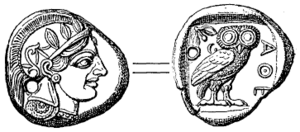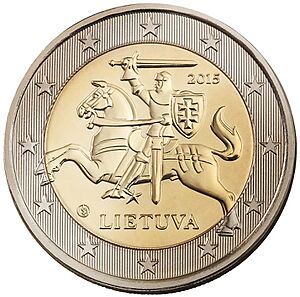Obverse and reverse facts for kids
Have you ever heard someone say "heads or tails" when flipping a coin? They are talking about the two flat sides of a coin! The obverse is the front side, often called "heads" because it usually shows a person's head. The reverse is the back side, often called "tails." These terms are used for coins, paper money, flags, medals, and other two-sided objects.
Contents
How to Identify Coin Sides
It's usually easy to tell the obverse and reverse apart. The side with the biggest picture, especially if it's a person's head, is usually the obverse. If that doesn't help, the side that looks most like other coins from that place is often the obverse.
For example, on famous ancient Greek coins from Athens, the head of the goddess Athena is on the obverse. Her owl is on the reverse. These two symbols were used on Athenian coins for over 200 years!
Ancient Coin Traditions
In many ancient Greek cities, like Athens, one side of their coins always had a symbol of their state. This was usually their main goddess or her symbol. This side was the obverse. The other side might have changed over time.
When kings started making coins, a larger image of a deity (god or goddess) was still called the obverse. A smaller picture of the king was on the reverse.
Alexander the Great's Coins
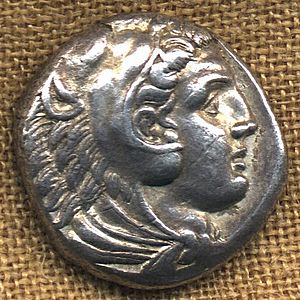
In the Western world, it became common for coins to show the head of the ruler on the obverse. This started with Alexander the Great. After he conquered ancient Egypt, he put his own image on the front of his coins. He wanted people to see him as a god-king, like the Egyptian pharaohs. This helped him gain the loyalty of the Egyptians. The rulers who came after him also put their images on the obverse of their coins.
Byzantine Coin Changes
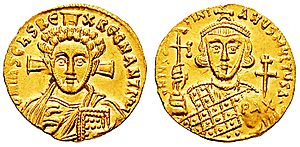
Later, in the Byzantine Empire, the tradition changed. A picture of Jesus Christ became the obverse, and the emperor's portrait was moved to the reverse. This change happened around 695 AD with the gold coins of Justinian II.
This new style upset the Islamic leader, Abd al-Malik ibn Marwan. He had copied Byzantine coin designs before, but now he created a new Islamic style. His coins had only writing on both sides, with no pictures of people. This "script alone" style was used on most Islamic coins until modern times.

After 695 AD, Islamic coins usually had only writing. The side with the Six Kalimas (the Islamic statement of faith) is usually considered the obverse.
When you see pictures of coins in museums or books, the obverse (front) is usually shown on the left or above. The reverse (back) is on the right or below.
Modern Coin Designs
Coins are used as a way to trade value. A country's government usually guarantees the value of its coins. This means the coin is worth something because the government says it is.
Most countries used to be ruled by kings or queens (monarchies). The king or queen was seen as the symbol of the state. So, the obverse side of a modern coin often shows a symbol of the country's strength, like its ruler or a national emblem.
The reverse side usually has information about the coin's value. It also often shows something about the country's culture, government, or land.
European Union Coins
For euro coins, it can be a bit confusing! Even though many countries have different designs for their coins, the official rule is:
- The unique national side (with a design from that country) is the obverse.
- The common European side (which shows the coin's value) is the reverse.
Some countries, like Spain and Belgium, still use pictures of their king or queen on the obverse. Ireland uses its national symbol, the harp.
Japanese Coins
In Japan, from 1897 until the end of World War II, there were informal rules for coin sides:
- The Chrysanthemum Crest, which represents the emperor's family, was on all coins. This side was the obverse.
- The other side, which showed the date, was the reverse.
After the war, the Chrysanthemum Crest was no longer used. So, the informal rules changed:
- The side with the date is still the reverse.
- The side without the date is the obverse.
United Kingdom Coins
Following a very old tradition, coins in the United Kingdom almost always show the head of the monarch on the obverse.
There's a special rule: each British monarch faces the opposite direction from the one before them. This tradition started in 1661. For example, George VI of the United Kingdom faced left, and the current Queen Elizabeth II faces right.
A small break in this tradition almost happened in 1936. Edward VIII wanted his image to face left, like his father's. But he gave up the throne later that year, so very few coins with his left-facing portrait were ever made, and none were officially released. When George VI became king, his image faced left, keeping the tradition going as if Edward's coins had shown him facing right.
Current UK coins have a Latin phrase: D(ei) G(ratia) REG(ina) F(idei) D(efensor). This means "By the Grace of God, Queen, Defender of the Faith."
United States Coins
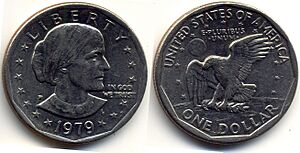
The United States government has specific rules for what appears on the front and back of its money.
Traditionally, US coins had:
- Obverse (Front):
* The word "Liberty" * The phrase "In God We Trust" * The year the coin was made
- Reverse (Back):
* The words "United States of America" * The phrase "E Pluribus Unum" (which means "Out of many, one") * Words stating the coin's value, like "Quarter Dollar" or "One Dime"
However, for the 50 State quarters series, which started in 1999, the rules changed a bit to allow more design space:
- Obverse (Front):
* Still has "Liberty" and "In God We Trust" * Now also includes "United States of America" and the coin's value (e.g., "Quarter Dollar")
- Reverse (Back):
* Still has "E Pluribus Unum" * Now includes the year the coin was made




